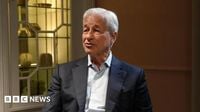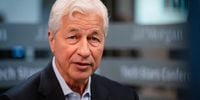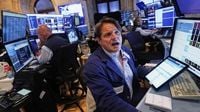Jamie Dimon, the influential CEO of JPMorgan Chase, is sounding an alarm that’s reverberating across Wall Street and beyond. In a series of candid interviews and public statements made in early October 2025, Dimon has warned that the risk of a major US stock market correction—a drop of at least 10%—is far greater than most investors and analysts currently believe. While the general market consensus pegs the probability of such a correction at around 10%, Dimon puts it at 30%, a figure that should give pause to anyone with a stake in the market.
According to the BBC, Dimon explained, “I am far more worried about that than others. I would give it a higher probability than I think is probably priced in the market and by others. So if the market’s pricing in 10%, I would say it’s more like 30%.” He cautioned that this correction could occur at any point within the next six months to two years, making the timing as uncertain as the risks themselves.
Dimon’s concerns come at a time when JPMorgan Chase itself is riding high. The bank’s share price has surged 29% year-to-date, pushing it tantalizingly close to a $1 trillion market capitalization, as reported by The Guardian. The bank’s return on tangible common equity (ROTCE) sits at a multi-decade high of 21%. Yet, beneath this impressive performance, Dimon sees danger signs—both for his own institution and for the broader economy.
Part of the reason for Dimon’s anxiety is the elevated level of stock market valuations and concentration. As of early October 2025, the S&P 500 had reached 33 record highs and was up nearly 15% for the year, according to Reuters. But the rally has been driven in large part by a handful of tech giants, with the 10 largest companies now making up a record 40% of the index’s market capitalization. Such concentration, Dimon warns, leaves the market especially vulnerable to shocks.
“Bull markets could go on a lot longer than you think,” Dimon acknowledged in his BBC interview, “but by many measures, valuations are high, which creates an element of risk.” He’s studied previous bubbles, such as the dotcom crash, and concluded that high valuations are often the only clear sign that trouble is brewing. “It’s really impossible to tell the burst,” he said, underscoring the unpredictability of market cycles.
The sources of Dimon’s unease are varied and complex. He points to a confluence of geopolitical tensions, increased fiscal spending, and what he describes as a world that’s become “more bellicose.” In his words, “There are a lot of things out there creating an atmosphere of uncertainty.” He’s even gone so far as to say, “People talk about stockpiling things like crypto. I always say we should be stockpiling bullets, guns, and bombs. The world’s a much more dangerous place, and I’d rather have safety than not.”
Global economic uncertainty isn’t just Dimon’s concern. Kristalina Georgieva, head of the International Monetary Fund, echoed similar warnings, urging the world to “buckle up” and stating, “Uncertainty is the new normal.” She emphasized that global resilience has not yet been fully tested, and there are “worrying signs the test may come.”
Dimon also zeroes in on the current hype surrounding artificial intelligence. The recent surge in tech stock valuations, especially those focused on AI, has drawn warnings from the Bank of England and tech leaders like OpenAI CEO Sam Altman. The Bank of England cautioned that “equity market valuations appear stretched, particularly for technology companies focused on artificial intelligence. This leaves equity markets particularly exposed should expectations around the impact of AI become less optimistic.”
Dimon agrees with this assessment, telling the BBC, “The way I look at it is AI is real; AI in total will pay off—just like cars in total paid off, and TVs in total paid off, but most people involved in them didn’t do well.” He added, “Some of the money being invested in AI will probably be lost.” This perspective, drawing on historical analogies, highlights the risk that not every investor in a revolutionary technology will emerge a winner.
JPMorgan’s own financials tell a story of both strength and vulnerability. While mortgage production in Q2 2025 was $11.2 billion—slightly down year-over-year but up quarter-over-quarter—auto loans have grown by 6% year-over-year, suggesting consumers are still willing to take on debt. However, a sharp 272% year-over-year rise in card services losses signals mounting stress among consumers, especially in unsecured lending. Dimon and his management team have not yet flagged this as a systemic issue, but it’s a data point that analysts and investors are watching closely.
Despite Dimon’s warnings, the mood on Wall Street remains moderately bullish. Of 20 analyst ratings in the past three months, 14 are bullish and six are neutral; none are outright bearish. Average price targets suggest a modest 7% upside from current levels, and consensus earnings per share estimates for Q3 2025 are up 10.5% year-over-year. Yet, there’s an undercurrent of caution, particularly around high valuations. As Dimon puts it, premium stocks like JPMorgan must “deliver or overdeliver”—a tall order in a market already pricing in near perfection.
Dimon’s reputation as a cautious, strategic leader is well-earned. He’s credited with steering JPMorgan through the 2008 financial crisis and making savvy moves like the acquisition of First Republic Bank in 2023. His advocacy for a “fortress balance sheet” has become legendary in banking circles. Yet, even he admits that the current environment is uniquely fraught. He’s described the US as a “less reliable” partner internationally and has expressed concern about inflation and the independence of the Federal Reserve, though he remains optimistic that the Fed will maintain its autonomy despite political pressures.
During a visit to Bournemouth in the UK, where he announced a £350 million investment in JPMorgan’s local campus and a £3.5 million philanthropic gift to local nonprofits, Dimon also praised the UK’s economic policies and innovation efforts. But when it comes to the US and global markets, his tone is markedly more cautious. “All these things cause a lot of issues that we don’t know how to answer,” he said. “So I say the level of uncertainty should be higher in most people’s minds than what I would call normal.”
Dimon’s warnings aren’t just theoretical musings—they’re grounded in data, history, and a pragmatic view of risk. As earnings season unfolds and the macroeconomic landscape shifts, investors face a stark choice: heed the caution of one of Wall Street’s most respected voices, or ride the wave of optimism that’s propelled markets to new heights. The next chapter for US stocks may well depend on how seriously the market takes Dimon’s message—and how prepared investors are for whatever comes next.
Dimon’s perspective stands as a rare counterweight to the prevailing exuberance, reminding everyone that vigilance and humility may be the best safeguards in an era defined by uncertainty and rapid change.


